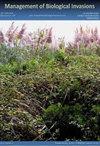Characterizing the suitable habitat of Miconia calvescens in the East Maui Watershed
IF 1.2
4区 环境科学与生态学
Q3 BIODIVERSITY CONSERVATION
引用次数: 4
Abstract
The East Maui Watershed (EMW) is a > 60,000-ha forested watershed with wide temperature and precipitation gradients being invaded by miconia ( Miconia calvescens DC.). Current miconia management efforts focus on protecting important watershed and critical habitat areas from miconia invasion. Herein, we report on a miconia species distribution model to predict unoccupied areas that may be still vulnerable to invasion. This suitable habitat model was developed from an ensemble of five algorithms associating five physical features of EMW with miconia occurrence data from a 26-yr management history (1991–2016; n = 114,953). All of the algorithms performed well based on model evaluation statistics (e.g. AUC ≥ 0.83; TSS ≥ 0.36). Elevation, slope and rainfall were consistently important predictors, while aspect indices were non-contributors. The binary ensemble model suggests a total of ~ 56.9% of the area of interest is susceptible to invasion by miconia. An independent dataset collected in 2017– 2018 (n = 5,222) was used to field validate the ensemble habitat suitability model (EHSM) and found that the model could correctly predict suitable habitat 94% of the time. All five of the model algorithms were updated using this new management data, and the predicted suitable area decreased 2.3%. While binary models are useful for risk assessment, the classification of an area as suitable or not suitable has limitations for land managers adopting for management activities. Utilizing the mean weighted consensus probability surface representation of the model allows for more scrutiny of potential suitable habitat. We suggest using this approach when planning future monitoring efforts, especially if specific areas have a higher prioritization for conservation than others.毛伊岛东部流域小仓鼠的适宜生境特征
东毛伊岛流域(EMW)是一个近60万公顷的森林流域,温度和降水梯度很宽,被miconia (miconia calvescens DC.)入侵。目前的管理工作主要集中在保护重要的流域和重要的栖息地免受薇卡菊的入侵。在此,我们报告了一个miconia物种分布模型,以预测可能仍然容易受到入侵的未被占领地区。该适宜生境模型是将EMW的五种物理特征与26年管理历史(1991-2016)的miconia发生数据相关联的五种算法综合而成的;N = 114,953)。基于模型评价统计(如AUC≥0.83;TSS≥0.36)。高程、坡度和降雨量一直是重要的预测因子,而向向指数则不是。二元集合模型表明,共有约56.9%的兴趣区域易受miconia的入侵。使用2017 - 2018年收集的独立数据集(n = 5,222)对集合栖息地适宜性模型(EHSM)进行现场验证,发现该模型可以正确预测94%的适宜栖息地。使用新的管理数据对所有五种模型算法进行了更新,预测的适用面积下降了2.3%。虽然二元模型对风险评估是有用的,但将一个地区划分为适宜或不适宜对土地管理人员进行管理活动有限制。利用模型的平均加权一致概率面表示,可以对潜在的合适栖息地进行更多的审查。我们建议在规划未来的监测工作时使用这种方法,特别是如果特定区域比其他区域具有更高的保护优先级。
本文章由计算机程序翻译,如有差异,请以英文原文为准。
求助全文
约1分钟内获得全文
求助全文
来源期刊

Management of Biological Invasions
Agricultural and Biological Sciences-Ecology, Evolution, Behavior and Systematics
CiteScore
3.40
自引率
6.70%
发文量
21
审稿时长
16 weeks
期刊介绍:
Management of Biological Invasions, established in 2010 by Dr. Elias Dana, is an open access, peer-reviewed international journal focusing on applied research in biological invasions in aquatic and terrestrial ecosystems from around the world. This journal is devoted to bridging the gap between scientific research and the use of science in decision-making, regulation and management in the area of invasive species introduction and biodiversity conservation.
Managing biological invasions is a crisis science, with Management of Biological Invasions aiming to provide insights to the issues, to document new forms of detection, measurements and analysis, and to document tangible solutions to this problem.
In addition to original research on applied issues, Management of Biological Invasions publishes technical reports on new management technologies of invasive species and also the proceedings of relevant international meetings. As a platform to encourage informed discussion on matters of national and international importance, we publish viewpoint papers that highlight emerging issues, showcase initiatives, and present opinions of leading researchers.
 求助内容:
求助内容: 应助结果提醒方式:
应助结果提醒方式:


